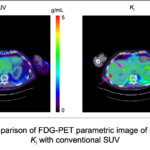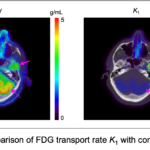Case 1 | Clinical Study – PET biomarker of liver inflammation in fatty liver disease
The diagnostic hallmark of nonalcoholic steatohepatitis (NASH) is liver inflammation in the setting of hepatic steatosis. The need for assessing liver inflammation, however, is mostly unmet yet in the clinic. FDG-PET has the potential to assess inflammation in the liver but standard static imaging, which measures standardized uptake value (SUV), did not demonstrate useful for characterizing liver inflammation. Instead, several studies show that SUV is more related to liver steatosis. With advanced tracer kinetic modeling that is developed specifically for dynamic liver PET data (Wang et al., PMB 2018, Zuo et al., PMB 2019), our team shows that liver FDG K1, the rate of glucose transport from blood to hepatic tissue, was highly correlated with liver inflammation grades as determined by liver biopsy as shown in Fig. 1, while SUV remained nearly unchanged (Sarkar et al. AJR, 2019, Sarkar et al. CGH 2020).

Case 2 | Clinical Study – Improved Lesion Detection in Cancer Imaging
 Dynamic PET imaging with tracer kinetic modeling may lead to improved lesion contrast in the parametric images as compared to conventional SUV images. For instance, detection of liver lesions has been challenging with static FDG-PET as many of the lesions do not show up in the SUV image. Fig. 2.1 shows that the parametric image of FDG influx rate Ki led to better visualization of liver lesions in a cancer patient with much-improved lesion contrast.
Dynamic PET imaging with tracer kinetic modeling may lead to improved lesion contrast in the parametric images as compared to conventional SUV images. For instance, detection of liver lesions has been challenging with static FDG-PET as many of the lesions do not show up in the SUV image. Fig. 2.1 shows that the parametric image of FDG influx rate Ki led to better visualization of liver lesions in a cancer patient with much-improved lesion contrast.
 In addition to assessing glucose metabolism, parametric imaging of the glucose transport rate K1 may bring the potential to improve brain lesion imaging as demonstrated in Fig. 2.2. The solid arrow points to an osteolytic lesion and the dashed arrow points to the brain. While the SUV image (and Ki image, not shown) demonstrated high uptake in the brain background, the K1 value was low in the brain but high in the osteolytic lesion, providing higher lesion-to-brain contrast.
In addition to assessing glucose metabolism, parametric imaging of the glucose transport rate K1 may bring the potential to improve brain lesion imaging as demonstrated in Fig. 2.2. The solid arrow points to an osteolytic lesion and the dashed arrow points to the brain. While the SUV image (and Ki image, not shown) demonstrated high uptake in the brain background, the K1 value was low in the brain but high in the osteolytic lesion, providing higher lesion-to-brain contrast.